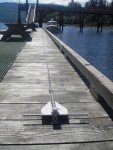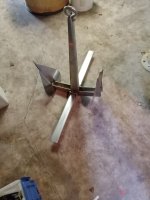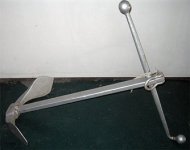My Key West 2020WA dragged an 11lb Danforth all night, last winter in Islamorada. I switched to an 8kg Bruce, and she set quickly and holds well.
Yes, like religion is an accurate statement!
What was the bottom condition?
"Danforth" has become almost a generic term. The majority of "Danforths" are not. a genuine Danforth. Even among the real Danforths. there is only one I use; that is the high test model. The are in the sizes: 5h 12h 20h 35h 60h 90h 150h & 190h. The high tensile have a "T" forged on the inner side of the fluke not the bent sheet metal, which most copies or cheaper Danforth have. The outer edges of the flukes are sharpened
the shanks are high tensile steel as is the rest of the anchor. The Fortress anchor is very similar but out of a high tensile aluminum.
MY 40# & 70# were WWII surplus anchors. During WW II Danforth anchors were used to winch landing craft out of shoal waters. I still have one of those anchors.
Note in my post I identified the 12# as
real550A identified his 2 anchors as "BRUCE", but also used the term "claw type anchor " which suggests that he knows that not all, and currently' claws are NOT BRUCES. I suspect that the claw type have a similar problem as the Danforths with copies.
Currently Danforth does not make a 11lb anchor. there are some knock offs such as Hooker who make badly shaped anchors which are called "Danforth". There a 316 SS 11# which some label "Danforth". That is very expensive & believe made in China.
Anchor tests are confusing, and some of the newer tests show real performance:
Steve's (Panope) tests. About 20. years ago I was giving some of the anchoring lectures at West Marine Trawler Fest. There there were less and inferior anchor tests, One of the best anchors was sort of a claw type. That was the Super Max. IT was hard to stow and expensive. The SUPERMAX is being made on a limited basis.
When we were doing long distance cruising we carried
three primary anchors: 70# genuine CQR plow. 70# Danforth, and a hand foraged "Fisherman" 70 #. all carried with chain & rodes attached on the bow sprit (62 foot pilothouse ketch.). We had duplicates of the plow and Danforth. We also carried a 12# & 20# HT Danforths, (lunch kedge and stern anchors) plus a 150 LB Hershoff storm anchor (in the bilge which broke down into three 50lb pieces. with 50 ' of 1/2 " chain & 300 feet of one inch nylon 3 strand rode. [/b]



